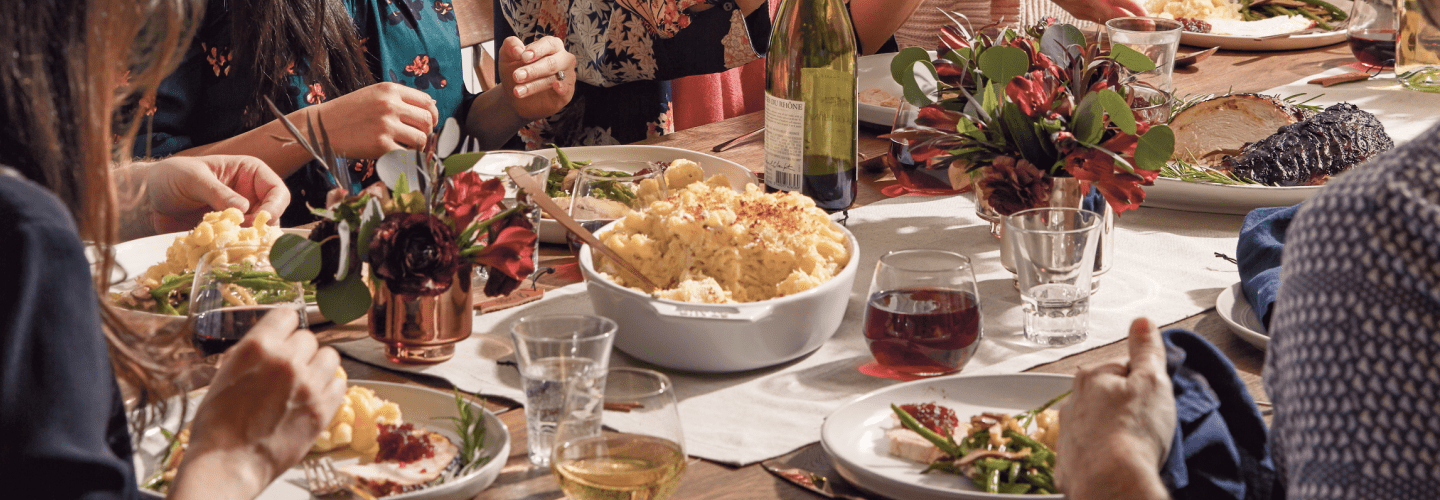AT THE MEALS THAT MARK LIFE’S BIGGEST EVENTS—that mark life’s biggest events—weddings, birthdays, promotions, holidays—food and wine pairing plays an integral part of the experience. Many people obsess over the dishes they choose and the bottles they pick to go with them. But even an everyday dinner can taste far better with the right wine. Here’s why, the next time you crack a bottle open for that meal you cooked, you’ll want to make sure it’s one that pairs well with the food.
3 Ways a Great Wine Pairing Can Make Dinner Better
Here’s something trophy-wine fans don’t often acknowledge: Wine is made to go with food,
for more than one reason

THE FLAVORS OF THE FOOD ARE ENHANCED. “A good pairing does three things for a dish. First, the pairing hits the palate gracefully with a body weight and strength of expression that mirrors the dish’s own weight and expression. Second, the pairing adds complementary flavors to the dish via the fruit, earth, floral, or wood notes within the wine’s flavor profile. Lastly, the pairing’s acidity, alcohol, and tannin serve to clean the diner’s palate of both the flavors of the dish and the wine, leaving the palate in a more neutral state,” explains Jason Ferris, manager and sommelier at the Park Inn in Hammondsport, New York. “These three effects create a cycle on the diner’s palate wherein the pairing glides seamlessly as it is consumed; then its complementary flavors step forward on the taste buds; and lastly, the wine erases the experience, leaving the diner wanting more food.”
“Perfect pairings take the simple tasks of eating and drinking—tasks we do ultimately for our own survival as often as 20 times a week—and elevate them to a surreal, transporting, and indelible experience.”
The results surprise and inspire. When CEO and founder Tracy Gardner set out to launch PairCraft, he decided that instead of creating pairings based on theories, as most sommeliers and wine educators do, he would take on the task from a practical point of view. Merging his chemical engineering skills with his extensive wine studies, Gardner developed a methodical pairing system that tests multiple wines with select dishes. The result unlocks the perfect food and wine pairings for consumers by removing all the guesswork. But it relies on the fact that, when the flavors of the wine meet the flavors of the food, novel things happen. “People think wine is static in the presence of food—that it doesn’t change; but on some level, everyone knows it does,” says Gardner. “I did some experiments with consumers a long time ago where I had 20 wines, had them taste all, then tell me which ones they liked. Next, I had them eat some food, taste the same wines after, and again, tell me which ones they liked. The first thing they said after they finished tasting the second time was that the wines they initially liked by themselves were not the same ones they had liked with the food.” That element of surprise is one of the most enjoyable things about wine pairing; it’s essentially a flavor adventure.
A simple meal gets elevated to an unforgettable experience. A simple meal gets elevated to an unforgettable experience. The right wine can accentuate or balance the sweetness, saltiness, and tartness in food, and when that perfect pairing is realized, nothing beats the dining experience. “There are only a few arts in the world that appeal to all five senses—food and wine are two of them. Knowing this, it’s only logical that their combination is perhaps the world’s highest art form,” says Ferris. “Perfect pairings take the simple tasks of eating and drinking—tasks we do ultimately for our own survival as often as 20 times a week—and elevate them to a surreal, transporting, and indelible experience that can last in our memory for a lifetime.”
